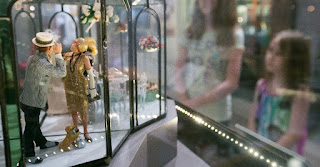Each of the women I encountered in Roar
Each of the women I encountered in Roar, the majestic ode to muliebrity in all its glorious hues—the good, the bad and the ugly—were memorable in their own way
Strangely when I think of memorable trippy whimsical women characters I think of only non-Indian films, like Jesse Buckley in I Am Thinking Of Ending Things. Or Olivia Colman in The Lost Daughter who ups and leaves her children because she can’t cope with the pressures of motherhood.
Years ago Reena Roy did that in J Om Prakash’s Apnapan. She left her child and marriage to pursue a career. She had to eat crow, shed buckets of tears of repentance and apologise to her husband. The only woman in Hindi cinema who was allowed to be whimsical in her life choices was Rosy in Vijay Anand’s Guide. She was “allowed” to leave her husband, live in with her lover and pursue her dancing career. The film was still a hit!
I spent four hours with eight gorgeous eccentric women in Apple TV’s Roar and trust me, it was every bit well worth my while. I’ve read reviews that have spoken of Roar tapering off into a whimper.
Ignore them. Very often we critics think of a clever headline and then fit our ideas into it. Roar deserves a standing ovation. I am not too sure, but I suspect the title comes from Helen Reddy’s feminist anthem: “I am woman hear me roar, in numbers too big to ignore.”
Memorable, of course, depends on what we as the audience value in life and in art; and by art, I mean popular art too. This is where Roar rests its grace. The first story kickstarting the zingy anthology is “The Woman Who Disappeared”. It features the drop-dead gorgeous Issa Rae as the writer of renown from New York who arrives in elitist LA to cut a lucrative deal, only to realise with growing horror that the men on the negotiating table, all white all opinionated, cannot see her. Why? Because she is Black? And A Woman?AND successful?
Now here is the thing: this episode as directed by Channing Godfrey Peoples, is way too symbolic and, what’s the word I am looking for, obvious: you know, white men not able to see a successful stunning black woman, etc etc?
I preferred the second story “The Woman Who Ate Photographs”, directed by Kim Gehrig if for no other reason, than because it features two fabulous actresses Judi Davis and Nicole Kidman, as mother and daughter, sparring as they go on a road trip. Both the actresses are in dishy form, giving each other tit for tat as we watch with a mix of amusement and anxiety.
What was the need for the bizarre twist wherein Ms Kidman eats pictures from her family album to relive the image associated with the picture, no kidding! Or for that matter Betty Gilpin as the “Woman Who Was Kept On A Shelf”. You may not be familiar with Gilpin. Now is as good as any time to get to know this astonishing actress who plays a reluctant bimbo who is put on a shelf, literally, by her tycoon husband so that he can worship-gaze her.
There is an interlude where Ms Gilpin jumps off the shelf and waltzes all over town revelling in her freedom. Such are the dreams Broadway musicals are made of! Director So Yong Kim makes terrific use of the airhead prototype to tell us something supremely sorrowful about a woman who is taught by her mother to marry the richest man who proposes to her. I know at least two such mothers in Bollywood.
The fourth story “The Woman Who Found Bite Marks On Her Skin" directed by Rashida Jones, is one of my least favourite. It covers no new ground. And the mandatory twist in the tale (the anthology would have worked so much better without it) is completely out of tune with the rest of the story of a successful woman who’s made to feel guilty for neglecting her family duties. Cynthia Erivo as the career woman who breaks into horrible abrasions all over the skin (guilt manifested) is all fire and fume, but it’s Jake Johnson as the househusband who has the tougher role.
Merritt Wever in “The Woman Who Was Fed By A duck” is the other super-standout unsung talent after Betty Gilpin. Wever plays a woman who befriends a duck at a park, brings him home, has sex with him, gets bullied by the duck after they….never mind. Providentially director Liz Flahive never gives us a chance to exclaim, ‘What the duck!’. No quack solution here for sure.
In one of the weakest stories “The Woman Who Solved Her Own Murder”, directed by Anya Adams, Alison Brie plays a slain woman who helps the cops try to solve her own murder. The mix here of the satirical and the ghoulish is decidedly foolish. I felt neither sad nor sympathetic towards the slain woman. When she reaches the denouement of her murder, the message of toxic masculinity is so overpowering, it feels like a jab in the butt after the pandemic is over.
The seventh story “The Woman Who Returned Her Husband” is the only one with an Indian connection. The wonderful Meera Sayal—does she ever disappoint?—is less than overwhelming as a bored housewife who wants to “exchange” her annoying husband (Bernard White) for a more exciting partner. The basic premise is silly and the direction by Quyen Tran is even sillier. Sayal is unable to elevate the material with her sparkling performance. Really, there is only so much that feminine chutzpah can do!
Finally, the Western noir film in the anthology “The Woman Who Loved Horses” is the weakest story in the collection. Fivel Stewart plays a girl who abandons her femininity to avenge her father’s murder, while Kara Hayward is her prim and squeamish partner in crime. By the time the two women sit down for a character-transforming chat with “murderer” Alfred Molina, I was thinking of Season 2 of Roar. I hope it happens.
Sure, not all the episodes of Roar…errr, roar. But none of them is ever a bore. The female heroes are not always consistent in their moral grounding or even their emotional pitch. But even when they are let down by shabby scripting or poor direction, they rise above their circumstances to shine beyond their prescribed karma.
Oh yes, not one well-rounded male character in this slick chick flick, except maybe Simon Baker as Nicole Kidman’s husband in the second episode. He, lucky sod, gets to kiss and cuddle Kidman. The other men in the anthology don’t stand a chance, One of them is a duck and the other wants to keep his wife on a shelf; another is so busy being a househusband he has no energy for sex.
These women don’t need men. They are on their own trippy trip.
Read Also :
Doctor Strange 2022 Film Online


Comments
Post a Comment